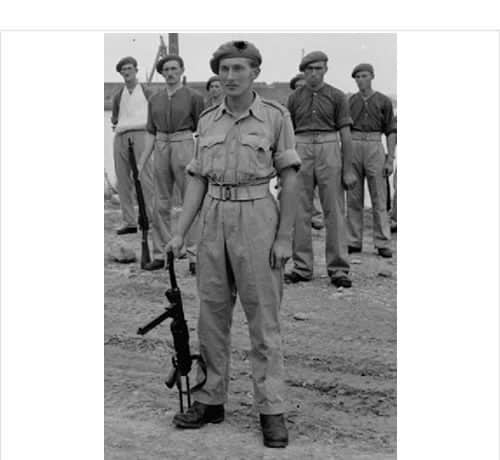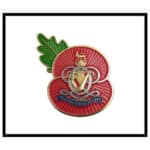3rd The King’s Own Hussars and SAS man who wreaked havoc behind enemy lines during the Second World War.
Major Roy Farran was born in India where his father was serving with the RAF. After Bishop Cotton School, Simla and Sandhurst, Farran was commissioned into the 3rd Carabiniers (Prince of Wales’s) Dragoon Guards. He served with 51st Training Regiment and was then transferred to the 3rd King’s Own Hussars in Egypt seeing action from December 1940 to February 1941 battle of Sidi Barrani. when Commonwealth forces defeated the Italian army in North Africa.
Farran took part in the battle for Crete but while leading a tank attack he was wounded and captured. For these actions, he received his first MC. After several attempts, he escaped under the perimeter fence from the Athens prisoner of war hospital and, with Greek help, secured a cacique and, with a motley group of British and Australians, sailed for Egypt. After a stormy nine-day passage, where they ran out of water, the party was picked up by a destroyer north of Alexandria – and Farran received a Bar to his MC.
By January 1942, Farran was ADC to Major General Jock Campbell, commander of the 7th Armoured Division. On February 26, shortly after Campbell’s, VC was gazetted, Farran was driving him when the car overturned and Campbell was killed. Wounded again later that year, Farran returned to England but was back in north Africa in early 1943. Here, after parachute training, he joined 2nd SAS.
He then led a raid on Cape Passero lighthouse in Sicily and carried out reconnaissance patrols and sabotage in the south. One of the most spectacular of these was in October 1943 when Farran dropped with a 2nd SAS detachment north of the River Tronto behind German lines. In five days his force destroyed transport, cut communications and blew up railway lines – a second Bar to his MC followed.
On August 19 1944,60 men and 20 Jeeps from the 2nd SAS landed by Dakota transport at the American held Rennes airfield. It was the beginning of Operation Wallace, one of the most successful post D-day SAS operations, and it was led by 23-year-old Major Roy Farran.
Farran penetrated 200 miles through enemy lines in four days, joining the base set up by the earlier Operation Hardy near Chatillon, north of Dijon. His operation, ending on September 17, resulted in 500 enemy casualties, the destruction of 95 vehicles, a train and 100,000 gallons of petrol. SAS casualties were light. On the way back through France, Farran’s squadron took illicit leave in Paris. Operation Wallace brought him a DSO.
Following Operation Wallace, and back in Italy, Farran took part in Operation Tombola, harassing the German withdrawal. Despite strict orders against taking personal command, Farran, wangling a flight in a US aircraft, managed to “fall out” just east of La Spezia where he joined up with his men. During the latter phase of operations, Farran raised the “Battaglione Alleato” comprising British, partisans and escaped Russian prisoners, which, in Albania and again against orders, attacked the German 51st Division headquarters. Farran anticipated a court-martial for disobeying orders, but the Americans awarded him their Legion of Merit, so the matter was dropped. He was in Norway when the war ended.
Postwar, Farran was in Palestine with the 3rd Hussars, followed by a posting to Sandhurst as an instructor. But with the end of the British Mandate in sight, he returned to Palestine. With the Palestine Police, he set up the “Q” patrols to infiltrate terrorist networks but was in serious trouble when it was alleged that a cap bearing his name had been found near where a 16-year-old Jewish youth had been abducted and allegedly shot. When the allegations became public, Farran was put under house arrest. Although he claimed to have a cast-iron alibi, when he heard he was to be charged with murder, he stole a vehicle and with others crossed into Syria where he contacted the British Legation in Damascus.
Prevailed upon to return, accompanied by a senior officer of the Palestine Police, Farran was detained in Allenby Barracks. Convinced the British would disown him in the interests of assuaging public opinion, he decamped but gave himself up when the Zionist terrorist group, the Stern gang, took reprisals against his friends. When Farran came to trial, the case was dismissed. No body had been found, and witnesses claiming to have seen the victim taken away failed to identify Farran in a line-up. When his youngest brother Rex was killed by a letter bomb sent to the family home a year after the boy’s disappearance, Farran, away at the time, suspected the Stern gang.
Once out of the army Farran seems to have found it difficult to settle. He worked as a quarry-man in Scotland, went to Africa and, in 1950, ran as Conservative candidate for Dudley and Stourbridge, losing to George Wigg, a future Labour minister. Farran then went to live in Alberta, Canada, where he spent the rest of his life. A man of many parts, Farran farmed and worked as a journalist and, in 1954, started the weekly North Hill News.
From 1961 to 1979, Farran was in the provincial legislature where he held two ministerial appointments. His later jobs included chairmanship of the province’s racing commission and, in 1980-5, he was a visiting professor at Alberta University. He later established a foundation in the French Vosges, providing Franco-Canadian student exchanges. For this, he received the Legion d’Honneur in 1994 to add to his 1946 Croix de Guerre.
Despite losing his larynx to cancer, he learned to speak through an incision in his throat and remained active. He published a number of books including two about his wartime experiences Winged Dagger (1948) and Operation Tombola (1960).
Roy Farran died aged 85.



